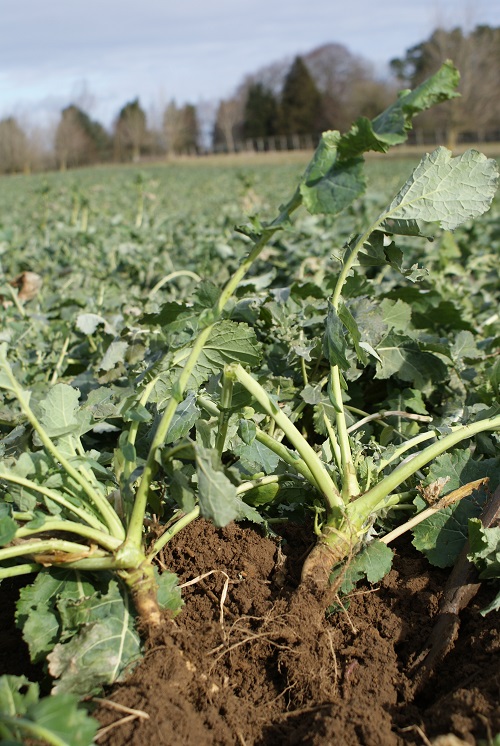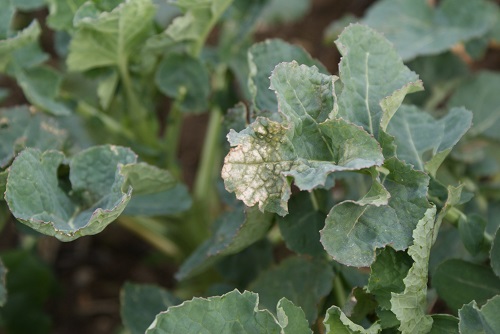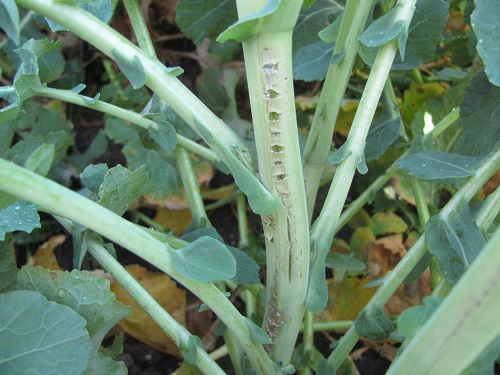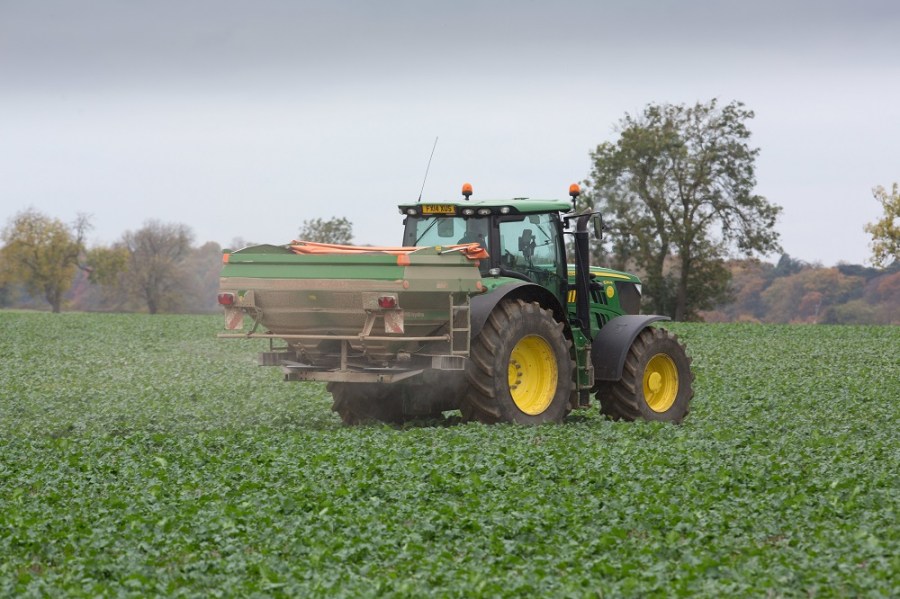Yields of OSR often fail to live up to their potential. CPM asks Hutchinsons’ Dick Neale how to avoid disappointment and finds out his top nutritional tips.
You’ve got to create conditions that give crops the best chance.
By Paul Spackman
Some growers may benefit from rethinking their approach to oilseed rape agronomy by taking a more balanced approach to applications of key inputs this spring, believes Hutchinsons’ technical manager, Dick Neale.
He warns that not enough attention is always given to the interrelationships between all aspects of macro and micronutrition, soil quality and fungicide inputs, which is putting crops at risk of missing their true potential.
All too often the focus is on specific areas of agronomy in isolation, particularly spring nitrogen, which is likely to be false economy if other aspects of crop and soil health are lacking, he points out.

Oilseed rape has a massive potassium demand, so crops must have sufficient root structure
“We’re increasingly seeing OSR yields of 5-6t/ha and if that’s something you’re regularly achieving you’ve got to create conditions that give crops the best chance of fulfilling it.
“Fundamentally this means getting soils into the right condition in terms of structure, pH, organic matter and fertility, which is a long-term process. But we can use nutrition to manipulate OSR quite strongly, providing everything is kept in balance.”
Spring nitrogen, for example, typically produces some of the most significant crop responses. But higher nitrogen rates must be accompanied by additional sulphur, as this is essential for efficient nitrogen utilisation, says Dick Neale.
Likewise, crops with high yield potential may also require more other macro/micronutrients and trace elements to grow properly. They’ll also likely require more robust fungicide applications to prevent early season canopy being lost to disease.
OSR typically requires around 650t of soil water for every tonne of rapeseed produced, so water-use efficiency is key, he adds.
“If you don’t have sufficient disease control or the correct balance of nutrition, plants won’t operate as efficiently so use more water and work harder putting on growth and sending roots deeper. This loses yield potential in the process.”

A separate spray for LLS and PGR may be necessary to get timing right.
The basic rule for optimising yield is to aim for a Green Area Index (GAI) of 3.5 by mid-flowering and growers should resist the temptation to grow big, lush crops. They may look good going into spring but are actually less efficient at building final yield, he advises.
“Crops need to be thin enough to let light penetrate the canopy and reach the lower leaves, which are far more efficient at building yield than the stems or pods. So don’t worry if your crop looks a bit thinner than neighbouring crops by the end of March, it’s often these that will yield better than thick, lush ones.”
In Dick Neale’s view, accurate timing of all nutrient applications is key to achieving this target GAI. Nitrogen usually gives the greatest yield response, but only if it is applied correctly in balance with other nutrients and if conditions are conducive for quick plant uptake, i.e. active growth.
Crops typically require 50kgN/ha to create one GAI unit, so this should form the basis for calculating spring applications. However, surface nitrogen applications are around 60% efficient and increase rates accordingly, within RB209 guidelines, to ensure enough nitrogen is taken up by the plant.

Many growers could be applying boron too early in the season.
“Don’t take a blanket approach to nitrogen. Manage every crop individually, according to its canopy size.”
He also points out there’s strong evidence showing the value of late liquid nitrogen.
“Applying all nitrogen early, in the hope the plant will use it later, doesn’t work. All that happens is the plant uses it early to produce a large canopy which intercepts light less efficiently. We’ve seen good plant uptake and yield responses from late nitrogen.”
For growers without the infrastructure to handle and apply liquid urea, other non-scorching, slow-release nitrogen products are available to mix with flowering sprays. Efficient 28 or Nitamin for example, are typically applied at 20 l/ha and Hutchinsons has found yield responses of 0.5t/ha, regardless of how much baseline nitrogen was applied, he explains.
Sulphur is essential for efficient nitrogen uptake and OSR is particularly sensitive to sulphur deficiency, characterised by yellowing or mottling of young leaves caused by plants not being able to utilise nitrogen properly. Slight deficiencies produce pale flowers.
Extra sulphur should always be included when considering higher rates of nitrogen, advises Dick Neale.
“Simply applying more of any nutrient when signs of deficiency are seen is too late. Plants will have already lost yield trying to recover and you won’t get that back.”
Many soils contain good phosphorous reserves, although only a proportion will be available for crop uptake.
Phosphorous is very chemically reactive and can easily become locked up in the soil, especially where there are high levels of background aluminium, iron and calcium, making it difficult to maintain available nutrient levels, he says.
Adding fresh phosphorous can be beneficial, although it must be applied when there is active growth and adequate moisture to ensure it is taken up by plants and not locked away in the soil.
“Don’t just apply phosphorous in the autumn and hope that will do. It has to directly feed the growing plant. DAP is frequently used when establishing winter OSR with great success, but this can cause localised and temporary increases in pH which may further impact micronutrient availability.”
OSR has a massive potassium demand, he notes, so crops must have sufficient root structure and moisture to access reserves within the soil profile.
“If the root system isn’t good enough, it won’t be able to meet the plant’s requirement. So be aware of other factors which may be influencing rooting, such as soil structure or other aspects of nutrition.”
Extra potassium may be necessary where soil indices are below the recommended Index 2, however Dick Neale believes that as with phosphorous, a spring application is far more beneficial than the autumn because it’s more likely to be quickly taken up by the growing plant.
Zinc deficiencies in OSR are an increasing issue and while there may be little direct yield response from additional zinc, it does play a key role in other aspects of crop health, notably stem strength, he says.
“If OSR lodges you will lose yield, so there is a benefit from avoiding zinc deficiency.”
Boron has a greater role in flowering and pod set than it does in early season growth and Dick Neale believes many growers could be applying it too early in the season.
“A lot of growers apply boron in the autumn, but I often question the value of this and believe early spring or green/yellow bud timing is more effective as this is when the crop needs it most.
“Be cautious with boron though, it’s a difficult product to tank-mix and should only be used in very small quantities to avoid having any toxic effect on the crop,” he adds.
Manganese is the main micronutrient to consider, while growers on black fenland should also be wary of potential copper deficiencies. Magnesium, while often applied alongside micronutrition, is in fact a secondary macronutrient so deficiency must be avoided, advises Dick Neale.
Two-sprays key to LLS control
Light leaf spot (LLS) is an increasing problem in OSR and growers should prepare to treat crops early this spring, advises Adama technical specialist Kuldip Mudhar.
Two spray timings are critical to LLS control; one in late autumn and the other as soon as the crop starts to ‘wake up’ in early spring, with a follow-up spray at green/yellow bud which will also help canopy management, he explains.
Prothioconazole and tebuconazole are the main actives offering good LLS control, so growers should use products based on these, Kuldip Mudhar advises.
Depending on crop development, he suggests there may be scope to combine LLS control with canopy management by selecting a fungicide with growth regulatory activity, such as Orius P (prochloraz+ tebuconazole).
But it’s not a case where there can be a compromise between disease control and canopy management. Early disease detection and control is more effective than treating heavily diseased crops at stem extension, so there may be a case for separate sprays depending on crop growth and disease pressure.
The key timing for growth regulation is from the onset of stem extension, when the internodal distance is between 20cm and 30cm. “Beyond 30cm is too late to get the best PGR effect,” he advises.




